
In 2019, FNY ran a piece about the Presidents of the United States whose names are represented in street names … whether the streets were named for former presidents or not. In fact, many of them were. This time, I have decided to run a piece about the names of the Presidents of the United States represented in subway station names. And, I’ll get this out of the way immediately: President Street itself, which runs through Park Slope and Crown Heights, is itself a stop on the #2/5 train, unusually built as an express station even though it sees only local service. Hey, Andy Sparberg, can you explain this anomaly?
All photos on this page appeared first in NYCsubway.org.
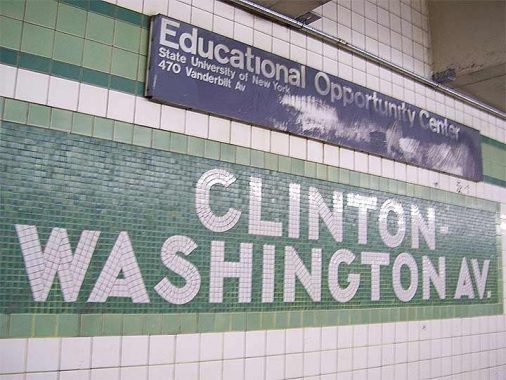
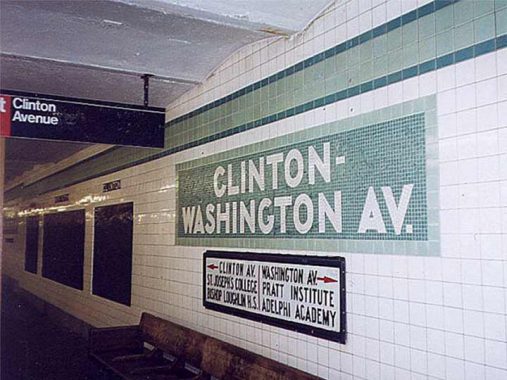


Oddly enough there are two separate Clinton-Washington avenue stations on IND lines in Brooklyn, one belonging to the Crosstown (G) and one a local stop on the Fulton Street line (C). Interestingly both bear green tile jobs; while most of the G line is tiled in green, only the local stations on the Fulton line between Hoyt-Schermerhorn and Nostrand Avenue get green.
Without a doubt, Washington is the most numerous street name among former presidents in NYC. As a military commander, he spearheaded the defeat of the British in the Revolutionary War, sealing American independence, and resisted entreaties to become a monarch, instead becoming the first head of America’s Executive Branch of governmental power.
No street named Clinton in NYC is of course named for Bill Clinton; you may have to go to Arkansas to find any. All Clinton streets in NYC are named for DeWitt Clinton, who held every possible major office in New York State and served as NYC mayor, and aspired to the presidency but didn’t get there.
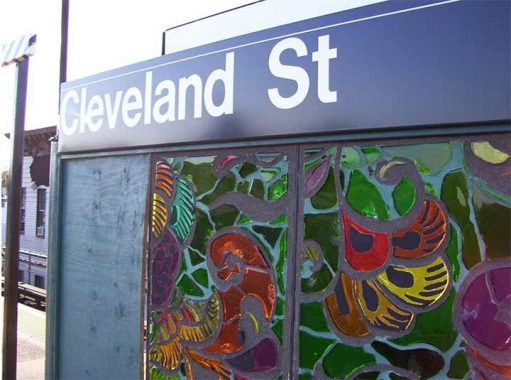

Democrat Grover Cleveland (who moved to New York State from New Jersey as a young man and served as mayor of Buffalo and NYS governor) holds the distinction of being the only president to be defeated for a second term and run again in the next election and win the rematch, becoming the only president to serve two nonconsecutive terms. He lost to Benjamin Harrison in 1888 and then defeated Harrison in 1892. The Statue of Liberty was dedicated during his first term in 1886.
Why Grover Cleveland got a street in East New York, well, I’ve never been afraid to admit, I dunno. {an answer has been found; see comments]
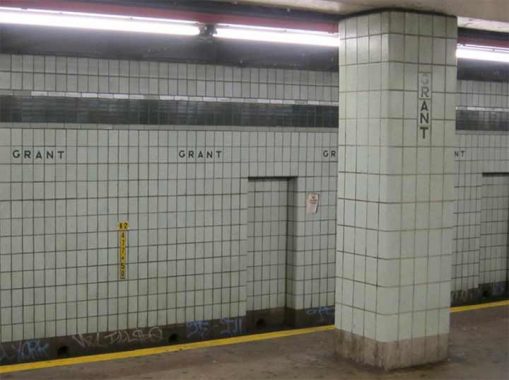

Grant Avenue is the last underground station as you travel east on the A/C train as A’s proceed either to Ozone Park or the Rockaways. It’s a relatively new station constructed in 1956 when the IND was connected to the east end of the Fulton El.
The avenue is indeed named for Ulysses S Grant, as a number of streets in Cypress Hills are named for Civil War figures such as Lincoln, Grant and Sheridan. While Abraham Lincoln was elected a second time, Ulysses S Grant was the first president to serve two full terms since Andrew Jackson, himself a wartime general who became president. He was the first of two presidents whose middle initial, S, was just an initial and didn’t stand for a name. Historians assert that Grant, who had alcoholic woes, was a less effective president that he was a military leader. Grant was in a run of 7 straight presidents with facial hair of some kind; Lincoln was the first to wear a beard, while Samuel Tilden would have broken the streak had he prevailed against Hayes.
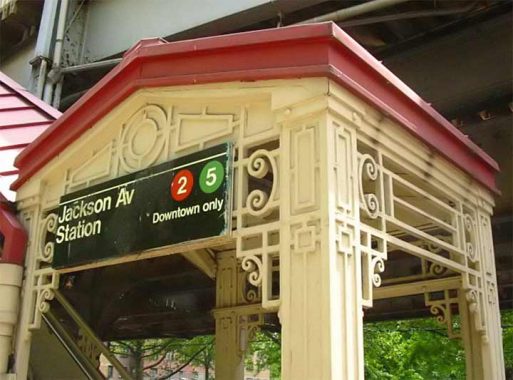


Two subway stations are named Jackson Avenue and neither is named for a President. While Jackson Avenue in Port Morris was named for landowner Washington Jackson in 1905…


…Vernon-Jackson Avenue remembers a 19th-century developer named John Jackson, who built a toll road in Queens that was named for him. At its western end it kept the Jackson Avenue name but east of Queens Boulevard, it lost its tollgates upon Queens’ admittance into Greater New York and became Northern Boulevard.
“Old Hickory” can definitely count Manhattan’s Jackson Street in the Lower East Side in his ledger.
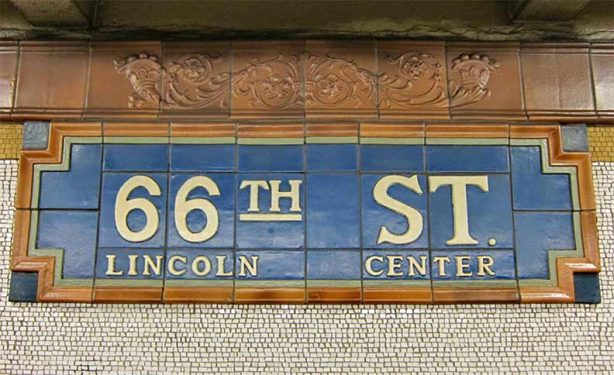

Oddly enough Abraham Lincoln’s name did not appear on any NYC subway signs save the Lincoln Road exit of the Q train at Prospect Park until 1990s station renovations of the 66th Street station added “Lincoln Center” to the signage. Until Robert Moses built Lincoln Center in 1959 the crossroads of Columbus Avenue and Broadway was called Lincoln Square.
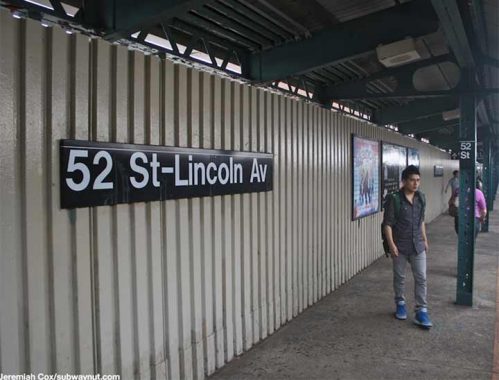

The Flushing Line preserves some ancient street names in station signage. If the long-awaited 52nd Street station renovation ever takes place, I’m not sure if its 52 St-Lincoln Avenue signs will survive. 52nd Street hasn’t been called Lincoln Avenue since about 1920 or so. Photo from the excellent Subway Nut.
New York City was a bastion of Confederate supporters, writes author John Strausbaugh in his book, “City of Sedition,” and was comprised of only the island of Manhattan during that era. Perhaps it is unsurprising, then, that only a few official locales in Manhattan were named for the Illinois Railsplitter, including Lincoln Center at Broadway and Columbus Circle, which was originally Lincoln Square; and the uptown Lincoln Houses, where Park Avenue meets FDR Drive. Abraham Lincoln kicked off his 1860 campaign for president in a speech at then-new Cooper Union, at Third Avenue and Astor Place, and local lore has it that afterward, he had a drink at nearby McSorley’s on East 7th Street.
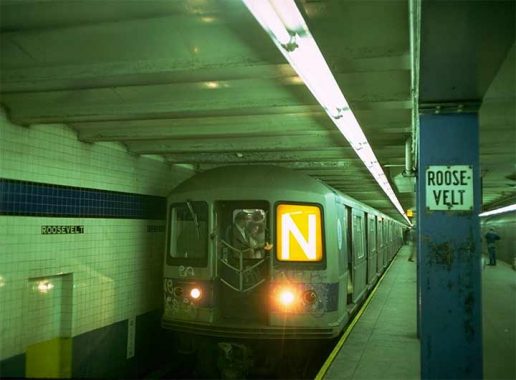




Teddy Roosevelt got himself a subway station when the IND was built out through Queens in the 1930s. Roosevelt Avenue itself was built in the early 1910s as the Corona Elevated was constructed, and when it was extended east to Flushing in 1928, the city switched Amity Street to Roosevelt Avenue.
One of the more storied presidents in history, Theodore Roosevelt was a warrior, explorer, reformer, governor and president, ascending to the White House after William McKinley’s assassination and winning election outright in 1904. He ran again under his own Bull Moose Party banner in 1912, but split the vote with his Republican successor William H. Taft, allowing Democrat Woodrow Wilson the presidency. As he was giving a speech in 1912, he was shot in the chest by a would-be assassin. He finished the speech.
Sorry, folks, my subway bullet collection is old and I don’t have any orange M’s.
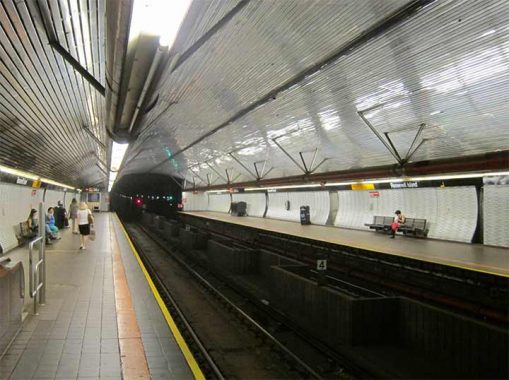

Franklin D. Roosevelt has had a station all his own since 1989, when the Roosevelt Island station, one of the deepest stations in the system requiring three escalator tiers to get to the bottom or top. Originally called a Native American term, the cigar-shaped island in the East River has gone through three names in English: Blackwell’s, Welfare and since 1972, Roosevelt Island. A park bearing a bust of the pride of Hyde Park opened in the 2010s after decades in the planning stages.
FDR is considered a titan of the 20th Century, assuaging the Great Depression (1929-1941) and overseeing the USA’s entry into World War II after the Japanese surprise attack on Pearl Harbor in December 1941. He approved the D-Day invasion of German-controlled France in June 1942. By his death in 1945 WWII was all but won, but his conference at Yalta with Winston Churchill and Joseph Stalin had set the stage for a longer conflict, the Cold War with the USSR and other Communist countries that continued until the USSR’s collapse in 1990 (Hostilities with Russia seem to be resuming at this writing.). Under Roosevelt, the USA became a true world power. He was the only president elected 4 times, as he continued to run for the presidency while the USA was embroiled in the war. No president since has run more than two times. He did it all from a wheelchair, as he was afflicted with polio as a youth.


Some of the best and most colorful subway mosaics can be found on the BMT Canarsie Line, built from 1924-1928 from 6th Avenue to East New York. Wilson Avenue is the only split-level subway station that has one platform outdoors and one indoors, and arrangement necessitated by the proximity of Evergreens Cemetery and its graves.
Despite the 1915 sinking of the Lusitania steamship liner and other German provocations, Woodrow Wilson campaigned for reelection in 1916 with the slogan “he kept us out of war.” By 1917, though, things were going so badly in Europe that America could be sidelined no longer and we went “over there.” Prohibition (of alcoholic beverages) was instituted under the Volstead Act in 1919.
The USA declared war on Germany April 6, 1917, after German submarines attacked several American merchant ships. Thus the USA entered the Great War, and this had an effect on the map of Brooklyn…
A few Brooklyn street names, it was decided, had to change if they named for German place names. Thus, Dresden Street in Arlington became Highland Place, Bremen Street in Bushwick became Stanwix, and Siegel Street, named for a German-born Union Civil War general, Franz Sigel, gained an extra “e”, perhaps to camouflage a German spelling. Most famously, though, Hamburg Avenue was renamed for the sitting president and became Wilson Avenue.
As always, “comment…as you see fit.” I earn a small payment when you click on any ad on the site.
2/21/22

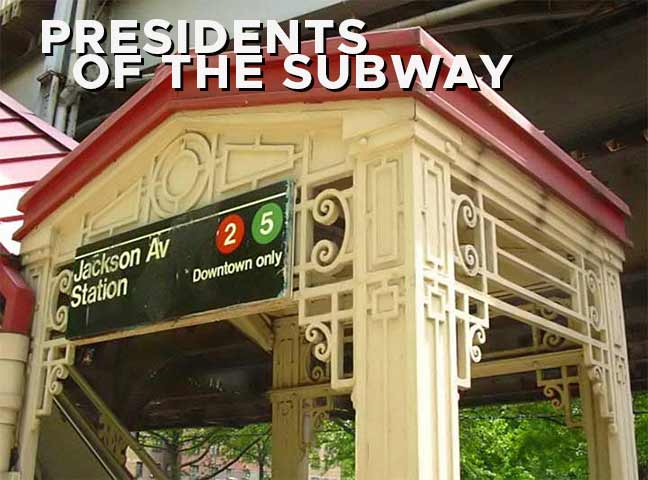
17 comments
You forgot Roosevelt Island on the F, named for FDR, also Jefferson St on the L for Thomas Jefferson which there is also a Jefferson Ave on the SIR (the only station named for a street on the SIR), plus Howard Beach-JFK Airport on the A
Love the old “N” train at Roosevelt Avenue. Never understood the reason to switch the ends of the “N” and “R” lines. Also remember the “EE” being discontinued and replaced with the”N”.
The reason for the N – RR switch in 1987 was to give each service access to a storage and inspection yard at the ends of the routes. When the RR operated between 95th-Bay Ridge and Astoria there was no yard near either end, so trains had to deadhead without passengers. When that is done the train crew is being paid and not carrying revenue passengers. The N, conversely, had yards near both Forest Hills and Coney Island.
Under the current setup R trains ending at Forest Hills are near Jamaica Yard; N trains are of course near Coney Island at their southern trip end.
Equipment storage was cited as the reason for the switch. As per Wikipedia: This was done to give the R direct access to Jamaica Yard. Previously, the N had direct access to both Jamaica and Coney Island Yards, while the R from Bay Ridge to Astoria lacked direct access to any yard. The change was intended to improve the appearance and reliability of service on the R, since all trains on the Astoria and Broadway Lines were part of the graffiti-free program (of the late 1980s).
Thanks Andy and Edward!
Sure Kevin, glad to assist.
In New York, so-called express trains typically serve part of a route as an express and part as a local, depending on the Manhattan trunk route, outer borough branch lines, and rush hour variations. The IRT can get especially complicated.
Brooklyn IRT services – #2, 3, 4, and 5 trains – are expresses when operating on their Manhattan trunk routes – 2 and 3 on the 7th Ave.-Broadway Line; 4 and 5 on the Lexington Ave. Line. So typically, people call the #2, 3, 4, and 5 trains “express” even though only a portion of their entire routes are true express trains.
Along the Brooklyn IRT four-track trunk between Borough Hall and Franklin or Utica Avenues, the #2 and #3 serve as the local service while the #4 and #5 are express trains. The branch between Franklin Ave. and Flatbush Ave. – Brooklyn College is two tracks, so regardless of the Manhattan origin of its two services, all trains serve each station, seven in all (President Street through Flatbush Ave.). All are built in typical local station format – President Street has a single island platform because of the station’s depth; the other six have side platforms.
The #2 runs 24/7 and doesn’t become express till Chambers St. in Manhattan. The #5 operates to/from Brooklyn between roughly 6 AM and 8:30 PM weekdays only and is an express north of Franklin Avenue.
It’s the same thing when the #2 and #5 operate through Upper Manhattan and The Bronx. The #2 is local from 96th Street all the way to 241st St. in The Bronx. The #5 becomes local once it enters The Bronx at 138th Street, all the way to Dyre Ave. Rush hour #5 trains take advantage of a third track and operate express in The Bronx (downtown in AM peak; uptown in PM peak) between 149th and 180th Strees.
The IND and BMT services have similar complicated details, but I won’t go into that info at this time.
Streets named “Clinton” can also be named after George Clinton., governor of New York and 4th Vice President.
The N and R were switched so that the R would have access to a yard.
The Brooklyn Daily Eagle from 5/6/1887 (page 2, col. 8) reports that the Common Council for the City of Brooklyn changed the names of several streets in the 26th Ward, which I believe was the former Town of New Lots annexed by Brooklyn in 1886. The Jefferson Street in New Lots became Cleveland Street. I am assuming a Jefferson Street already existed in Brooklyn. (Thank you for maintaining your site for all these years.)
If I remember correctly the N to R terminal switch (Ditmars Boulevard-71st Street/Continental Avenue) was to allow R trains to use Jamaica Train Yard, before the switch the R didn’t have direct access to any train yard and R trains would have to be sent for service to Coney Island Yard over other track lines during off-peak hours.
Cleveland Street was named for President Grover Cleveland, who was in office at the time the street was renamed. It was formerly Jefferson Street. This was one of a group of five streets in East New York named for the first five U. S. presidents; Washington (now Warwick), Adams (now Ashford), Jefferson (now Cleveland), Madison (now Elton) and Monroe (now Linwood) Streets. In January 1887 the New Lots Board of Trade recommended to the Brooklyn City Council the renaming of 67 streets in the former Town of New Lots, with the proposed names having the same initial letter as the original name. The name recommended for Jefferson Street was Jerome Street (ultimately used in renaming John Street); after consideration the name Cleveland Street was chosen. Renamed (to eliminate duplication with Jefferson Street in Bushwick and Jefferson Avenue in Bed-Stuy) on April 11, 1887, effective April 26, 1887.
Sorry to report that your comment about Lincoln not receiving his Subway recognition id very wrong. The 52nd Street / Lincoln Avenue station of the Flushing 7 line opened in 1917 and is still going strong.
I should add that as well as Roosevelt Island which commemorates FDR.
Thanks for this entry with so much information. I might as well be the the first to mention that the C DOES NOT stop at Grant Avenue. It’s terminus is one stop west at Euclid Avenue.
fix done
Please forgive me if this post is a little nit-picky, but there are two stations that recognize President James Madison, even though Madison is not in the official station name. The E and M train stop at 53rd St.-Fifth Avenue has a secondary access at Madison Avenue and 53rd St. Further south on the Lower East Side, the F train stop at East Broadway also has a secondary access at Madison and Rutgers Streets. Madison Avenue and Street are not connected; they are at minimum three miles apart.
I would think that 181st Street station on the 1 , which has mosaic tile work naming the George Washington Bridge would qualify for this page. Also, the 34th street station on the A/C has mosaic tilework for Madison Square Garden.
“New York City was a bastion of Confederate supporters….”
And wanted to secede from the Union during the Civil War!